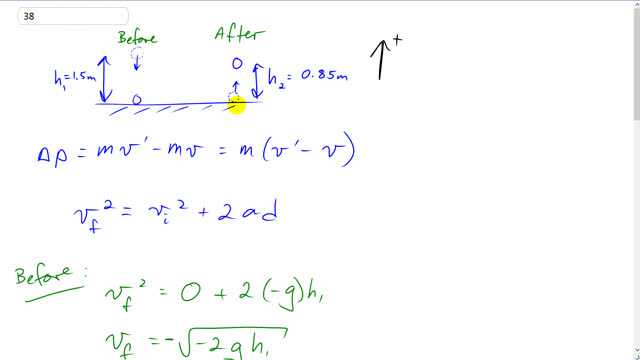
You drop a 14-g ball from a height of 1.5 m and it only bounces back to a height of 0.85 m. What was the total impulse on the ball when it hit the floor? (Ignore air resistance.)

In order to watch this solution you need to have a subscription.
This is Giancoli Answers with Mr. Dychko. Before the ball collides with the ground, it falls some height 1.5 meters and then after its collision with the ground, it gets some impulse imparted to it by the ground and then it's launched back up in the air but it only goes 0.85 meters up. So to find the impulse, we take mv prime which is the velocity it has right here just as it's leaving the ground and then minus the momentum it has just before it hits the ground so v is the velocity it has right here. So it basically doesn't change its position at all between when we measure v prime and v when it has velocity v, it's just beginning to squish and then when it has v prime that's when it's done its rebound, and is just about to launch off the ground. Okay and we can factor out the common mass, m and it's v prime minus v. So our job then is to figure out what these two velocities are. We'll use this kinematics formula to figure out each of them and so let's consider the before case when we were trying to find v— the velocity that it has after falling 1.5 meters. So the final velocity squared equals 0 because there's no initial velocity, it's dropped from this height 1.5 meters, it's not thrown down nor upwards plus 2 times acceleration which is negative g times the displacement which is going to be h 1. So v f is... we'll take the negative square root; when you take the square root of both sides, you can choose to take the positive or the negative square root and in this case, we can see that v f is downwards and so we are gonna choose the negative square root so it's negative square root of negative 2gh 1 and v f here is—just reminding you—v. Okay. Now after when its rebounding, it goes up to some height 0.85 meters and at that point, its final velocity is 0 and so what must have its initial velocity, launching off the ground, have been in order to reach that height. And so we'll subtract 2ad from both sides and we get v initial squared is negative 2ad and that's the square root of negative 2 times acceleration which is negative g times h 2 and negative and a negative makes a positive so this v i is square root 2gh 2 and v i here is the velocity as its launching off of ground, v prime. And so plug in those things and then calculate. So impulse is m times v prime minus v. The v prime is square root 2gh 2 and then we have minus v so that's a minus from the formula and then negative because this v is directed downwards so that's negative square root of negative 2gh 1. So that makes a plus in the end. and we can factor out the square root 2g from each of these terms and we have m times square root 2g times square root of h 2 plus square root of negative h 1. And plugging in numbers, we have 0.014 kilograms times square root of 2 times 9.8 meters per second squared times the square root of 0.85 meters is the displacement in the after case it's going upwards in the positive direction so its displacement is positive, 0.85 meters and then plus the square root of negative negative 1.5 meters, the displacement in the first case is downwards and so it's negative 1.5 and then these two make a positive which is good because otherwise our calculator would complain if we tried to take the square root of a negative number. 0.13 kilogram meters per second is the impulse; it's positive so it's directed upwards.